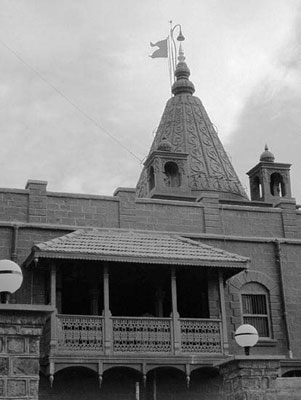
The day that Baba took mahasamadhi, Tuesday, 15 October 1918, was a highly auspicious and holy one in both the Hindu and Muslim calendars. It was the ninth day of Ramzan (a major festival and fasting month for Muslims) and it also happened to be the major Hindu festival of Vijayadasami. Furthermore ekadasi (a significant time in the lunar cycle of the Hindu calendar) had just started. Two months previously Baba had sent a message to Banne Mia fakir, saying that "on the ninth day, of the ninth month, Allah is taking away the lamp he lit". He also sent some offerings to the fakir Shamsuddin Mia and a request to do moulu and qawalis (both are types of devotional singing) and nyas (feeding of the poor). Thus right up until his final moments in the body, Baba was embracing both communities.
The news of Baba's passing spread quickly, and thousands came to Dwarkamai for a final darshan, queuing for five or six hours. The body was kept on a hand-cart all night, while the preparations - digging a pit and building the platform - went on. Before the burial, Baba's kafni was removed and he was given a final bath. It is reported that even at this stage his body remained soft, as if he were merely sleeping. Earlier, while the body was in the wheelchair, his nose started to bleed (usually impossible in a lifeless body).
Twenty-six hours after he had left his body, Baba was finally interred. Certain personal articles were buried with him: the broken brick, now mended with gold and silver wire; one of his satkas; a chillim; needle and cotton (Baba would mend his clothes until they were a mass of repairs, a cause of affectionate amusement among close devotees); some spices to preserve the body; and an old cloth bag that Baba never allowed anyone to touch, but which devotees investigated after his mahasamadhi and found that it contained a green kafni and a cap.
The burial was completed by Wednesday evening and the tomb sealed. A photograph of Sai Baba was placed on a throne on the platform above the tomb. It remained there until the statue was installed in 1954. That picture is now kept in the recess of the Samadhi Mandir where some other articles used or touched by Baba are on display.
The mandir that we see now is about twice the size of the original building, having been later extended back from the stone arches. As the temple authorities try to find new ways of coping with the ever-increasing flow of visitors, various alterations are made. In 1998 a hall, adjoining Dwarkamai, was added to the back of the mandir, so that it has again almost doubled in size. Devotees who wish to spend time in the Samadhi Mandir may use this part of the building.


